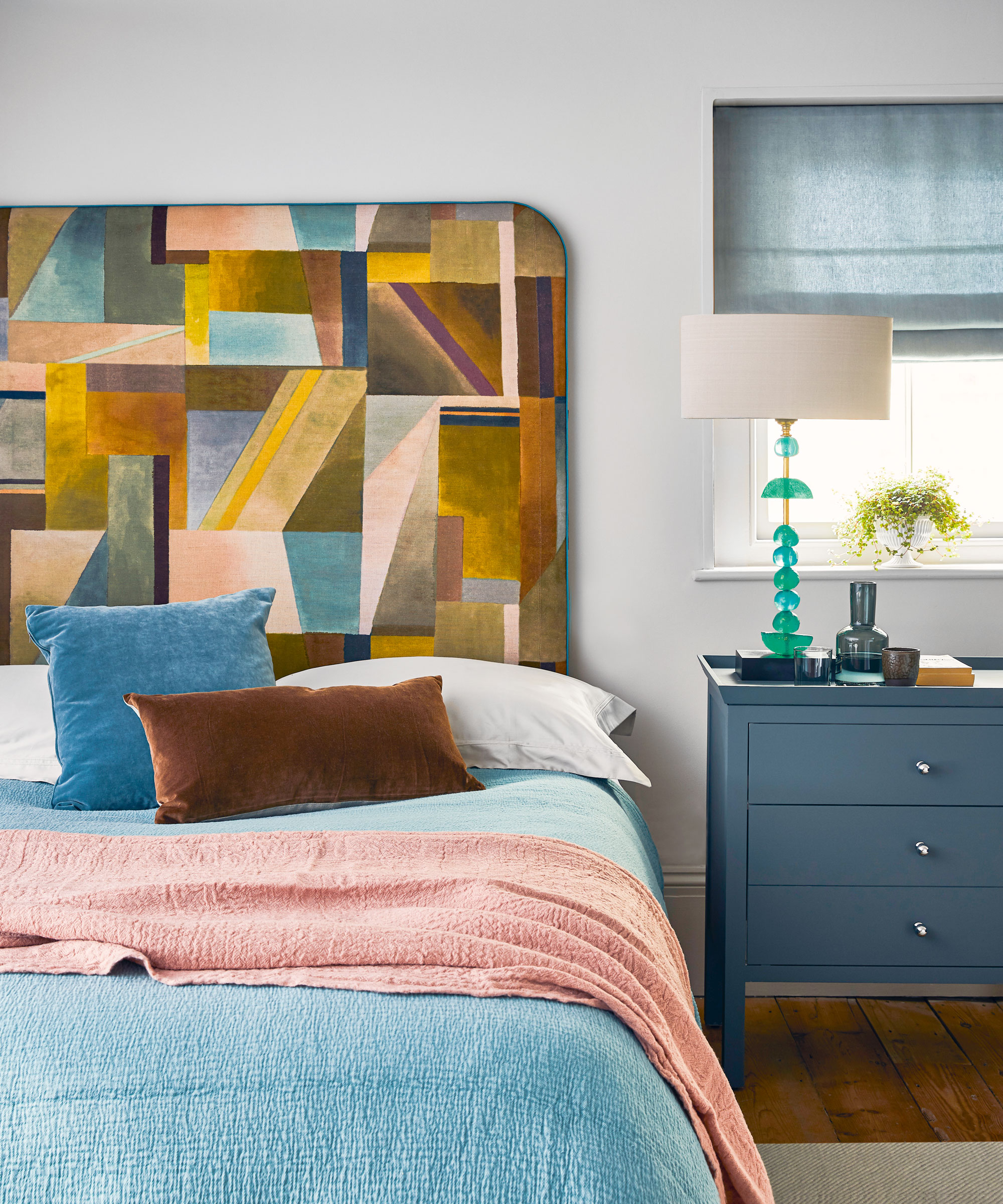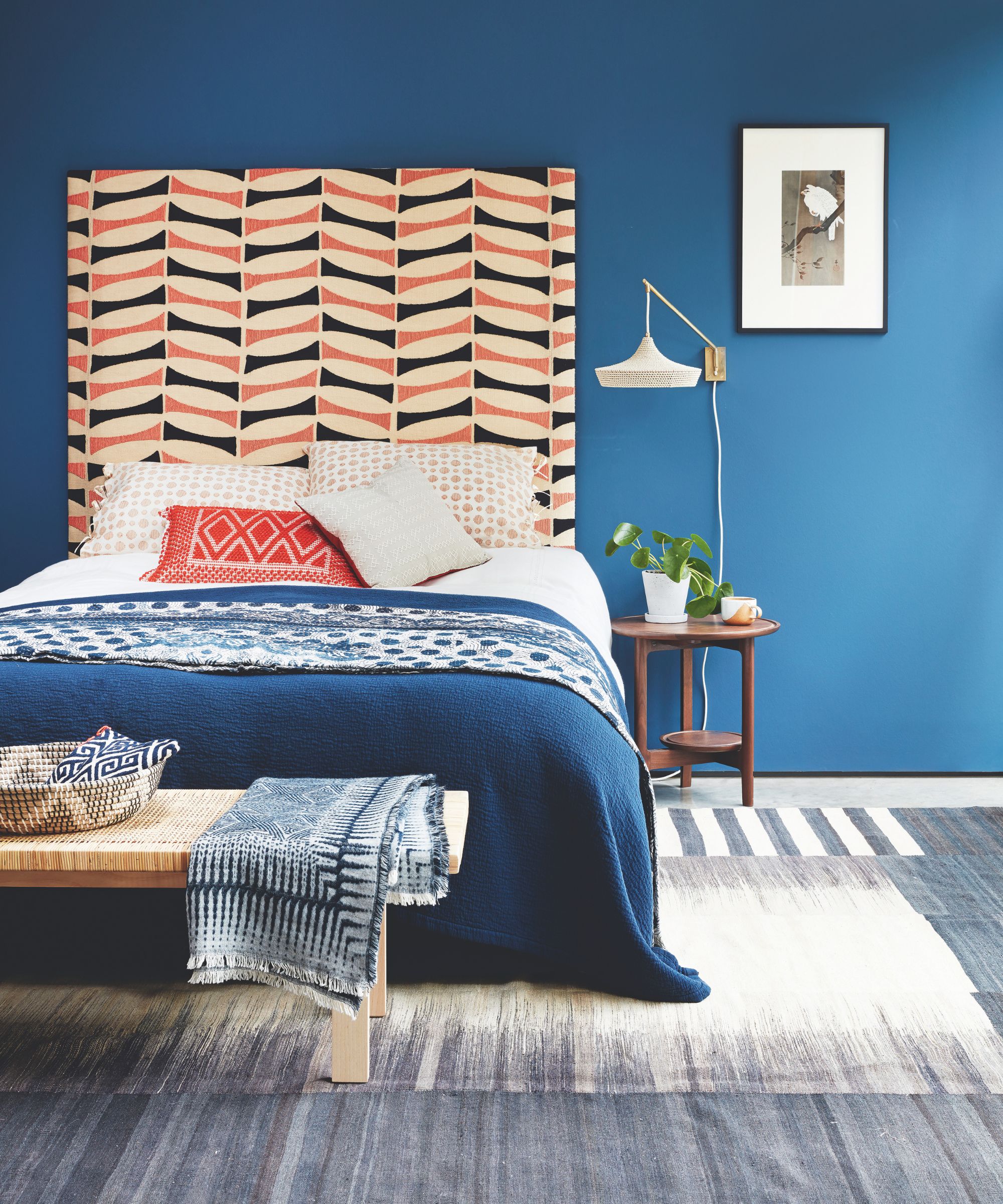
- 1. General clear out
- 2. Declutter clothes
- 3. Group belongings
- 4. Stylish storage
- 5. Use underbed storage
- 6. Declutter throw pillows
- 7. Clear floors
- 8. Assess your furniture
- 9. Sort cords
- What to shop
- How do you declutter a small bedroom?
- How do I organize my bedroom with too much stuff?
- Meet our experts
Struggling to figure out how to declutter a bedroom? We're here to help.
Your bedroom should be a serene space for rest and relaxation, so if yours isn't, it's high time you got started. Your space will thank you, and you'll even sleep better, too.
Here, professional organizers share how to harness the very best decluttering tips to make a lasting impact on your space.
How to declutter a bedroom like a pro
When decluttering your bedroom for that sought-after spacious and serene feel, it’s easy to get wrapped up in the finer details; however, sometimes the simplest things can be the most effective, such as making the bed, for example.
‘Coming home after a long day to a beautifully made bed helps not just the room feel airy and less cluttered, but your mind, too. And a decluttered mind means better sleep,' says professional organizer Julie Onstot of Sort Well Organizing Co.
With that in mind, we’ve put together a list of effective – yet surprisingly simple – ways to declutter your bedroom. Let's begin with the basics.
1. Start with a general clear out

The quickest way to get started is by getting rid of items you know for sure you don't need or want
Too many things that always make your bedroom feel cluttered will quickly make the space feel small, cramped, less usable, and less enjoyable. So, when decluttering your bedroom, the key is to think like a minimalist, so long as you avoid any minimalist decluttering mistakes.
Design expertise in your inbox – from inspiring decorating ideas and beautiful celebrity homes to practical gardening advice and shopping round-ups.
As Shannon Krause, chief operating organizer at Tidy Nest, highlights, a good way to start is by giving some thought to the room's primary purpose – sleeping better. Anything that's not conducive to that should be housed elsewhere.
‘Your bedroom should be a place of rest and relaxation, so bringing anything into the space that alters that energy is a hard no from us,' she says. ‘Paperwork, homework, or anything to do with your profession or education should live outside of the bedroom – bringing it in is a constant reminder that you have a to-do list waiting for you’.
Then, focus on the things to get rid of, which will likely be anything you don't need, haven't used, likely never will, or that you have multiple of.
Begin this part by clearing visual clutter from your bedroom, advises Amanda Wiss, founder of NYC-based home organizing company Urban Clarity. Remove everything from your dressers, declutter nightstands, bedside tables, and vanities, before sorting through the items individually.
‘Make it your goal to not allow clutter to build back up on these surfaces,’ she says.
You can then decide whether to donate or sell decluttered items afterward.
Then, go more granular. Decluttering can be an overwhelming process, so don't try and tackle it all in one go. Clearing surfaces will make a huge impact alone. Then, you can move on to more time-consuming tasks, such as organizing drawers.
As Jenon Bailie, design director for Room & Board, says, ‘Clutter creates bad energy. Reduce it by ensuring everything has a home!’
2. Declutter your closet

Cut clutter in your closet and donate items you never wear
People often feel reluctant to make use of closet decluttering tips and declutter their clothes, but ultimately, if they don’t fit in your closet, or you don't wear them, it's time to get rid of them.
Piles of ‘unhomed’ items lying around are not conducive to a spacious, clutter-free feel. To avoid it, you’ll need to declutter according to the storage you have.
Laura Price, professional organizer at The Home Organisation advises, ‘To make it less of an overwhelming task, try editing category by category in short bursts of 20-30 minutes. Take out all of your sweaters and decide which ones you actually wear.
'Then move on to pants, skirts etc. Breaking it down and seeing everything in front of you makes it much easier to make decisions. When everything fits in your closet, the room will instantly feel bigger and more manageable.'
With more closet space available, you’ll also have the option to move bedroom items behind closed doors for a more streamlined feel. Consider dedicating a shelf to ‘knick-knack’ prone categories, such as your jewelry or make-up, for example.
You can then aesthetically organize your closet. For this, Amanda suggests beautifying the storage space with one simple trick: uniform velvet hangers, such as the HOUSE DAY White Velvet Hangers available at Walmart.
‘I think you get a huge bang for your buck by changing over to all matching hangers in your closet,’ she says. ‘I love ivory-colored velvet hangers and firmly believe that matching hangers, all hung in the same direction, is a very quick and relatively inexpensive way to overhaul any closet for a calm and organized vibe.’
Speaking of closets, it's not just the clothes in your closet that you need to clear. Anyone who has a chair in their bedroom knows how quickly it can become a dumping ground for clothes.
'Put your shirts in the right drawer instead of leaving them on that chair in the corner!' says designer Breegan Jane. ‘Assigning spaces for your things and then being mindful about always placing them where they belong will keep the space free and clear.’
3. Group belongings mindfully

Thing carefully about items you want to keep on display after you've decluttered your bedroom
Bedroom styling extends to surfaces; get these in shape and you will have a more streamlined feel overall. So it’s important to put as much thought into how you display items on your bedroom surfaces as you do into the items themselves.
Meaningful, artistic arrangements will add aesthetic value, as well as functionality. A good rule of thumb is to group items in odd numbers, ensuring plenty of space around them.
Using a pretty tray such as the Raquel velvet oval mirror one from Anthropologie can corral items into a neat little shape, but keep it to a maximum of four items.
According to Heather Goerzen of Havenly, nightstands in particular are clutter-prone areas that truly benefit from a considered, ‘less-is-more’ approach, getting rid of any items cluttering your bedside table to stop nightstands becoming catchalls once and for all.
‘Position a lamp for ambient lighting, and then add essentials only: your latest book, a relaxing candle and a small catch-all dish for jewelry and glasses, for example. Don’t forget to deal with cords – these can be one of the most visually jarring things in a bedroom, so hook them to the back of your nightstands to keep them out of sight,' she says.
Moving any of the things not to store on your nightstand will also contribute to a more streamlined space.
4. Incorporate stylish storage for easy access

Use storage baskets and bins to hide clutter
When decluttering a bedroom, it’s important not to lose sight of practicality. Otherwise, you won’t thank yourself when you’re rushing to get ready in the mornings! The trick is to find a way to keep essentials close to hand, without sacrificing on a stylish, clutter-free scheme.
Chic storage baskets, boxes and containers are great for containing small knick-knacks and ‘unsightly’ essentials, and look lovely integrated into curated groupings.
Avoid transparent materials if you can, as too much open storage on-show can make a room feel overly full, and choose stackable designs to save on space. These have the added benefit of concealing everyday items, creating a visually calm space.
As Vicky Silverthorn of You Need a Vicky advises, most items will be in drawers or closets, but anything below eye-level should have a lid. 'Baskets are particularly good for easy access,' she says.
For this, designer Breegan uses and loves the Best Choice Multipurpose Hyacinth Storage Baskets available at Target, and there are plenty of stylish options on Walmart too, like the gorgeous Rattan Box Storage Basket with Lid available at Walmart.
Dedicate a drawer or a basket to different items – organizing makeup in one, organizing jewelry in another, for example, so you can reach straight for what you need.
5. Utilize space under the bed

Don't let unused space go to waste
Often overlooked, underbed storage ideas offer up a wealth of storage opportunities without taking up extra floor space.
Pull out drawers, bags, such as the Amazon Basics Under Bed Storage Container Bags available at Amazon, or boxes (measure beforehand for a snug fit) are useful, but be aware that out of sight usually means out of mind, so schedule in regular time to declutter and organize the area under the bed to keep them relevant.
‘This is often a place where items go to die,’ says Amanda. ‘Make sure you know what lives under your bed, and go through what's there with a judicious eye. Do you really need it taking up physical and mental space in your home?’
Amanda also refers to this space as a holding area. ‘You know deep in your heart that these things can probably be thrown out or donated, but you're holding on to them just to be sure you don't need them, just one more time,’ she says, and the subtext is clear – donate or toss!
If you don’t want boxes on show, an ottoman-style bed is a great option for maximizing space, lifting to reveal plenty of storage space inside. This isn’t something you’ll want to do every day, so be sure to fill it with items that you don’t need daily access to, such as storing clothes for the longer term.
If you’re still struggling for space, consider moving non-seasonal items outside of the room altogether – bedding and clothing, for example. This is where vacuum pack storage comes in handy; pack up and label each bag clearly, then relocate them to your loft or garage.
We recommend the number one bestselling Vacuum Storage Bags available at Amazon.
6. Toss or donate those throw pillows

A few throw cushions and pillows artfully arranged, this like, can look gorgeous, but don't go overboard
It’s possible someone in your life has already told you this, but you might have too many throw pillows. Amanda says less is more, and we tend to agree, so decluttering them from your bedroom will ease the visual load.
‘A few carefully chosen decorative pillows add texture and color, but at some point the scales tip and too many pillows just end up adding to the cluttered and chaotic feel,’ she warns.
7. Keep the floor clear

Clear floors will make your room feel both bigger and calmer
As Katherine Blackler of SortMySpace Ltd points out, ‘Keeping floors clean, tidy and clear of clutter will trick your brain into thinking the space is larger than it is.
‘The brain subconsciously scans a room for its perimeter, so the further you can see, the calmer you’ll feel.'
In general, piles of dirty laundry and shoes tend to be the main culprits – investing in effective bedroom organizers, such as well-placed baskets and hampers, is the easiest way to keep them at bay.
Pick a stylish design if it’s out on show, or opt for a lidless version if you’re storing it inside a closet.
The key thing here, though, is to keep clutter firmly off your floors. Our content editor Chiana Dickson found this to be an unexpected but welcome side effect of having one of the best robot vacuum cleaners running automated cycles around her home.
8. Assess the scale of your furniture

Make sure your furniture works with your space, not against it
Bedroom furniture is often very expensive, which can make decluttering any of it all the more difficult.
But, as the main goal of decluttering your bedroom is clearing the clutter away for a calmer, more streamlined space, designer Bregan suggests assessing the scale of your furniture, and deciding if they are working with your room, or against it.
‘Don’t crowd a small space with oversized furniture,’ she says.
Instead, weed out what isn’t working and re-sell or give it away to someone local, to declutter without throwing away.
‘Then, select pieces that are in proportion with the rest of the room,' recommends Bregan.
Our bedroom furniture ideas will provide some inspiration for new pieces.
9. Manage your cords

Keep cords out of sight for a tasteful, clutter-free bedside table
We have all read the advice. It’s bad to sleep with tech anywhere in the room, let alone next to your bed. Unfortunately, it’s a bad habit many of us find hard to break, but design expert Jenon says the least we can do is get all our cords under control.
‘Cord management helps reduce the feeling of unruly cords,’ she says. ‘Using both closed and open storage can help to hide away the things you don't want to see.’
This is especially true if you’re using multiple chargers for multiple devices, and find your bedside table can’t handle all the clutter. Taking a minute or so to do a little cable organization will leave things more zen.
Alternatively, use a charging station, such as the Belkin MagSafe Charger available at Amazon, to cut down on wires while keeping everything organized and accessible.
What to shop
All prices were correct at the time of publication.

These sturdy storage boxes are ideal for overhauling your underbed storage, with a clear design for easily identifying items, and smooth rolling wheels for convenient access.

This heavy-duty lidded storage trunk made of water hyacinth wicker is perfect for blankets, cushions and pillows, and looks stylish displayed at the end of your bed or against an empty wall.

Your storage solutions don't have to be boring. In fact, they definitely shouldn't be. This basket is handwoven from seagrass, with handy integrated handles for easy portability.
FAQs
How do you declutter a small bedroom?
Space constraints pose a big challenge when it comes to efficient bedroom organization, so decluttering a small bedroom – and keeping it clutter-free – is essential.
The process can be daunting, so don’t attempt it all at once. Set yourself sensible time limits and realistic goals to keep motivation levels high, and focus on one area at a time, the closet or the nightstand, for example.
When decluttering a small bedroom in particular, there’s no room for ‘maybe’ items – quite literally. So be strict with yourself.
If you’re decluttering sentimental items, it might be worth asking a friend for some moral support. For items you truly can’t part with, seek out other areas of the home to store them in, such as the attic or garage, but limit yourself to just one box if possible.
How do I organize my bedroom with too much stuff?
The truth is you can’t organize a bedroom with too much stuff. Not efficiently, anyway. So, task number one is to declutter your bedroom thoroughly.
The aim is to wind up only with items you truly need in your life, so bear this in mind at all times. Ask yourself when you last used or needed an item. If it was more than a year ago, get rid.
Once you’ve worked through everything, look at what you’re left with and establish which items belong in a bedroom. If they’re not serving the purpose of a good night’s sleep, relocate them elsewhere.
Then, rethink your storage options. Is what you’ve currently got working hard enough? Consider investing in under-bed storage such as pull-out bins with viewing windows from Amazon, or multifunctional furniture pieces to utilize the space you’ve got to its best potential.
Meet our experts

Amanda Wiss is the founder of Urban Clarity, a home organizing company awarded NY Magazine’s Best of NY 2023. She is also the founder of home staging studio Urban Staging, whose design-savvy team gets homes market-ready, to intrigue brokers and buyers alike. The two companies work in conjunction to do full move management, getting their clients completely unpacked and beautifully settled, while minimizing stress.

Breegan Jane is a TV host, designer, entrepreneur & philanthropist in Los Angeles. Breegan’s signature style meshes the artistic and elegant with livable comfort. She achieves a stunning, modern aesthetic with decor that maximizes elegance and fosters simplicity, serenity, and supreme comfort.

Tidy Nest was launched in 2019 by Shannon and her husband Jared. Together, for the last six years they've worked all over the country, and have been featured in Apartment Therapy, Forbes, The Spruce and more.
Are there other areas of your home needing attention? Tackle the items to get rid of in your living room, tick off your bathroom decluttering checklist and declutter a small kitchen with our expert-led guides.

Ottilie joined Homes & Gardens in 2024 as the News Writer on Solved, after finishing a Master's in Magazine Journalism at City, University of London. Now, as the Sleep Editor, she spends her days hunting deals and producing content on all things sleep – from mattresses and sheets to protectors and pillows, all of which she tests in her own home. She also has particular expertise in home fragrance, covering everything from candles to reed diffusers.
Previously, she has written for Livingetc and Motorsport Magazine, and also has a Master's degree in English Literature and History of Art from the University of Edinburgh, where she developed a love for inspiring interiors and architecture.
- Tara KingContributing Editor

